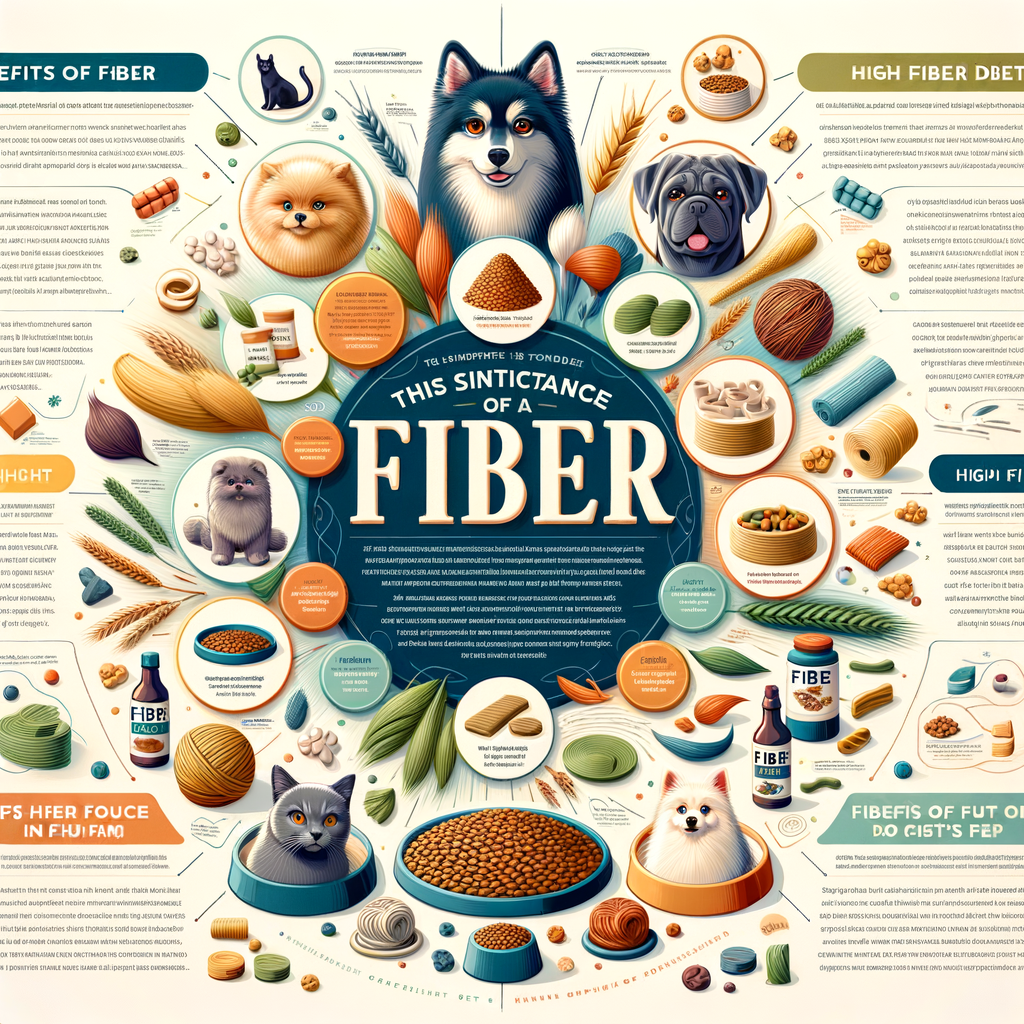
Introduction: The Importance of Fiber in Pet Diet
When it comes to feeding our pets, we often focus on the basics: proteins, fats, and carbohydrates. However, there’s another crucial component that often gets overlooked – fiber. Fiber plays a significant role in your pet’s diet, contributing to their overall health and well-being in several ways. This article will delve into the importance of fiber in pet nutrition, helping you understand why it’s a vital part of your pet’s diet.
- Understanding the role of fiber in pet nutrition
- Why fiber is a crucial component in your pet’s diet
Fiber, a type of carbohydrate, is a crucial part of your pet’s diet. Unlike other carbohydrates, fiber isn’t digested by your pet’s body. Instead, it passes through the digestive system relatively intact, performing several important functions along the way. Fiber aids in digestion by adding bulk to the stool, helping your pet maintain regular bowel movements. It also helps control weight by making your pet feel fuller for longer, reducing the chances of overeating. Additionally, fiber can help manage certain health conditions in pets, such as diabetes and heart disease, by slowing the absorption of sugar into the bloodstream and reducing cholesterol levels.
Now that we understand the role of fiber in pet nutrition, let’s explore why it’s so important. First, a diet rich in fiber can help prevent constipation in pets. When your pet consumes fiber, it absorbs water and expands in the stomach, helping to push food through the digestive tract more efficiently. This can help prevent constipation and promote regular bowel movements. Second, fiber can help your pet maintain a healthy weight. Because fiber-rich foods are typically low in calories and take longer to digest, they can help your pet feel fuller for longer, reducing the likelihood of overeating. Lastly, fiber can contribute to your pet’s overall health by supporting a healthy gut microbiome. The gut microbiome, a community of beneficial bacteria in your pet’s digestive tract, plays a crucial role in digestion, immunity, and overall health. Fiber acts as a prebiotic, providing food for these beneficial bacteria and helping them thrive.
In conclusion, fiber is a crucial component of your pet’s diet that shouldn’t be overlooked. By understanding the role of fiber in pet nutrition and incorporating it into your pet’s diet, you can help ensure your pet’s health and well-being.
Understanding Pet Fiber Diet
When it comes to our pets’ health, diet plays a crucial role. One of the key components of a healthy diet for pets is fiber. But what exactly is a pet fiber diet? Let’s delve into this topic.
What is a Pet Fiber Diet?
A pet fiber diet is a specially planned diet for pets that includes a high amount of dietary fiber. This type of diet is designed to support the digestive health of your pet.
- Defining a high fiber diet for pets
- How a fiber-rich diet differs from regular pet food
A high fiber diet for pets is one that includes at least 5-10% of fiber. This can be achieved by including certain types of food in your pet’s diet, such as vegetables, fruits, and whole grains. Fiber is an essential nutrient that aids in digestion and helps maintain a healthy weight in pets.
Regular pet food often lacks the necessary amount of fiber needed for optimal health. It usually contains more proteins and fats, with little to no fiber content. On the other hand, a fiber-rich diet for pets is packed with fiber-rich foods like peas, beans, and oats. This type of diet not only supports digestion but also helps in weight management and blood sugar regulation.
In conclusion, a pet fiber diet is a great way to ensure your pet’s overall health and well-being. By understanding what it is and how it differs from regular pet food, you can make better dietary choices for your pet.
Benefits of Fiber in Pet Food
Feeding your pet a diet rich in fiber can bring about numerous health benefits. Let’s explore these benefits in detail.
- Improved Digestive Health
Fiber plays a crucial role in enhancing your pet’s digestive health. It aids in the smooth functioning of the digestive system, ensuring that your pet’s body can efficiently break down and absorb nutrients from food. This leads to regular bowel movements, reducing the risk of constipation and other digestive issues. A study conducted by the University of Illinois found that dogs fed a high-fiber diet had healthier gut bacteria compared to those on a low-fiber diet.
- Weight Management
Weight management is another significant benefit of a high-fiber diet for pets. Fiber-rich foods tend to be more filling, which means your pet will feel satisfied after eating less. This can help prevent overeating and obesity, a common problem in pets that can lead to numerous health issues. According to the Association for Pet Obesity Prevention, approximately 56% of dogs and 60% of cats in the U.S. are overweight or obese. A high-fiber diet can be a practical solution to this growing issue.
- Regulation of Blood Sugar Levels
Fiber can also help regulate your pet’s blood sugar levels. It slows down the absorption of sugar into the bloodstream, preventing sudden spikes and drops in blood sugar levels. This is particularly beneficial for pets with diabetes. A study published in the Journal of Veterinary Internal Medicine found that diabetic dogs fed a high-fiber diet required less insulin and had fewer blood sugar fluctuations than those on a low-fiber diet.
In conclusion, incorporating more fiber into your pet’s diet can significantly improve their overall health and wellbeing. It’s a simple change that can make a big difference.
Sources of Fiber for Pets
One of the most important components of a pet’s diet is fiber. It plays a crucial role in maintaining their digestive health. Let’s delve into the sources of fiber for dogs.
Dietary Fiber for Dogs
Dogs, just like humans, need a balanced diet to stay healthy. A significant part of this balance comes from dietary fiber. Let’s explore the common sources and examples of high fiber dog food.
- Common sources of dietary fiber for dogs
- Vegetables: Carrots, peas, and green beans are excellent sources of fiber for dogs.
- Fruits: Apples and bananas can provide a good amount of fiber.
- Grains: Brown rice and oatmeal are also rich in fiber.
- Examples of high fiber dog food
- Blue Buffalo Wilderness High Protein Dog Food: This food is rich in protein and fiber, making it an excellent choice for your dog.
- Nutro Ultra Weight Management Adult Dry Dog Food: This dog food is designed for weight management and is high in fiber.
- Hill’s Science Diet Dry Dog Food, Adult, Perfect Weight for Weight Management: This dog food is another great option for weight management and is rich in dietary fiber.
Fiber for dogs can come from a variety of sources. Some of the most common ones include:
Remember, it’s essential to introduce these foods gradually into your dog’s diet to avoid any digestive upset.
Many commercial dog foods are high in fiber. Here are a few examples:
Always consult with your vet before making any significant changes to your pet’s diet.
High Fiber Cat Food
Just like humans, cats also require a balanced diet to maintain their overall health. One of the essential components of a cat’s diet is fiber. Let’s delve into understanding the unique fiber needs of cats and explore some examples of high fiber cat food.
- Understanding the Unique Fiber Needs of Cats
- Examples of High Fiber Cat Food
Cats are carnivores by nature, but they still require a certain amount of fiber in their diet. Fiber aids in digestion, helps maintain a healthy weight, and can even help prevent certain health issues like constipation and diabetes. Unlike dogs, cats need a specific type of fiber known as insoluble fiber. This type of fiber doesn’t dissolve in water and adds bulk to the diet, helping cats feel full and promoting regular bowel movements.
There are many high fiber cat foods available in the market. Here are a few examples:
| Brand | Product | Fiber Content |
|---|---|---|
| Blue Buffalo | Indoor Hairball & Weight Control Natural Adult Dry Cat Food | 10% |
| Royal Canin | Feline Health Nutrition Digest Sensitive Loaf in Sauce Canned Cat Food | 1.5% |
| Natural Balance | L.I.D. Limited Ingredient Diets Green Pea & Chicken Formula Grain-Free Dry Cat Food | 5% |
Remember, it’s always best to consult with your veterinarian before making any major changes to your cat’s diet. They can provide personalized advice based on your cat’s age, weight, and overall health.
Fiber Supplements for Pets
Just like humans, our furry friends also need a balanced diet to stay healthy. One crucial part of this balanced diet is fiber. Sometimes, the food we give our pets may not provide enough fiber, and that’s where fiber supplements come in.
- When and why to consider fiber supplements for your pet
- Popular fiber supplements for dogs and cats
There are several reasons why you might want to consider fiber supplements for your pet. If your pet has been having problems with digestion, such as constipation or diarrhea, a fiber supplement might help. Fiber can also help your pet feel fuller, which can be beneficial if your pet needs to lose weight. Additionally, fiber can help control blood sugar levels, which is especially important for pets with diabetes. It’s always best to consult with your vet before starting any new supplement regimen.
There are many fiber supplements available for pets, but some are more popular than others. For dogs, one of the most popular fiber supplements is psyllium husk, which is a natural source of soluble and insoluble fiber. For cats, wheat bran is often recommended because it’s easy to mix into their food and it’s a good source of insoluble fiber. Other popular options include beet pulp and pumpkin, both of which are rich in fiber and can be easily added to your pet’s regular food.
Remember, every pet is unique and what works for one may not work for another. It’s always best to consult with your vet before making any changes to your pet’s diet or supplement regimen.
Practical Tips for Implementing a Fiber-Rich Pet Food Diet
Feeding your pet a high fiber diet can have numerous benefits, including improved digestion and weight management. However, transitioning your pet to a new diet should be done gradually and under close observation. Here are some practical tips to help you make this transition smoothly and effectively.
Transitioning Your Pet to a High Fiber Diet
Changing your pet’s diet abruptly can cause digestive upset. Therefore, it’s important to transition your pet to a high fiber diet gradually and monitor their response closely.
- Steps to gradually introduce more fiber into your pet’s diet
- Monitoring your pet’s response to a high fiber diet
Start by mixing a small amount of the high fiber food with your pet’s current food. Gradually increase the amount of high fiber food over a week or two, while decreasing the amount of their current food. This will allow your pet’s digestive system to adjust to the new diet slowly.
Keep an eye on your pet’s behavior and bowel movements. If your pet is adjusting well, they should remain active and their bowel movements should be regular and firm. If your pet shows signs of discomfort, such as vomiting, diarrhea, or loss of appetite, it may be necessary to adjust the amount of fiber or consult with a vet.
Remember, every pet is unique and may respond differently to dietary changes. It’s always best to consult with a vet before making significant changes to your pet’s diet. They can provide guidance based on your pet’s specific needs and health condition.
Consulting with a Vet
When it comes to your pet’s diet, especially when considering a significant change like introducing more fiber, consulting with a vet is crucial. A vet’s guidance can be invaluable in ensuring your pet’s health and well-being.
- The Importance of Vet Guidance When Changing Your Pet’s Diet
- How a Vet Can Help Ensure a Balanced and Nutritious Diet for Your Pet
Changing your pet’s diet is not a decision to be taken lightly. It can have significant effects on their health, both positive and negative. This is where a vet comes in. They can provide expert advice based on their knowledge of animal nutrition and your pet’s specific needs. For instance, they can guide you on how to gradually introduce more fiber into your pet’s diet to avoid digestive issues. They can also help monitor your pet’s response to the new diet and make necessary adjustments.
A vet can play a crucial role in ensuring that your pet’s diet is balanced and nutritious. They can evaluate your pet’s overall health, consider their age, weight, and lifestyle, and recommend a diet that meets all their nutritional needs. When it comes to a fiber-rich diet, a vet can advise on the right amount of fiber your pet needs and the best sources of fiber to include in their diet. They can also guide you on whether your pet might benefit from fiber supplements.
In conclusion, a vet’s guidance is essential when changing your pet’s diet. They can provide expert advice and help ensure that your pet’s diet is balanced, nutritious, and beneficial to their health. So, before you make any significant changes to your pet’s diet, make sure to consult with a vet.
Conclusion: The Power of Fiber in Your Pet’s Diet
As we wrap up this comprehensive guide on the importance of fiber in your pet’s diet, let’s take a moment to revisit the key points we’ve covered.
- Recap of the benefits of a fiber-rich diet for pets
- Final thoughts on the importance of fiber in pet nutrition
Fiber plays a crucial role in your pet’s diet. It aids in digestion, helps maintain a healthy weight, and can even contribute to reducing the risk of certain diseases. We’ve learned that fiber can help your pet feel fuller for longer, preventing overeating and obesity. It also aids in the regulation of blood sugar levels, which is especially beneficial for pets with diabetes. Furthermore, a fiber-rich diet can significantly improve your pet’s bowel movements, reducing the likelihood of constipation and diarrhea.
Ensuring your pet gets enough fiber is not just about their immediate health – it’s about setting them up for a long, happy, and healthy life. Whether it’s through high-fiber pet food, supplements, or natural sources like fruits and vegetables, there are numerous ways to incorporate more fiber into your pet’s diet. Remember, every pet is unique, and what works for one may not work for another. It’s always best to consult with your vet to determine the best dietary plan for your furry friend.
In conclusion, the power of fiber in your pet’s diet cannot be overstated. It’s an essential component that contributes to their overall health and well-being. As pet owners, it’s our responsibility to ensure our pets are getting the nutrients they need, and fiber is certainly one of them. Here’s to happier, healthier pets!






